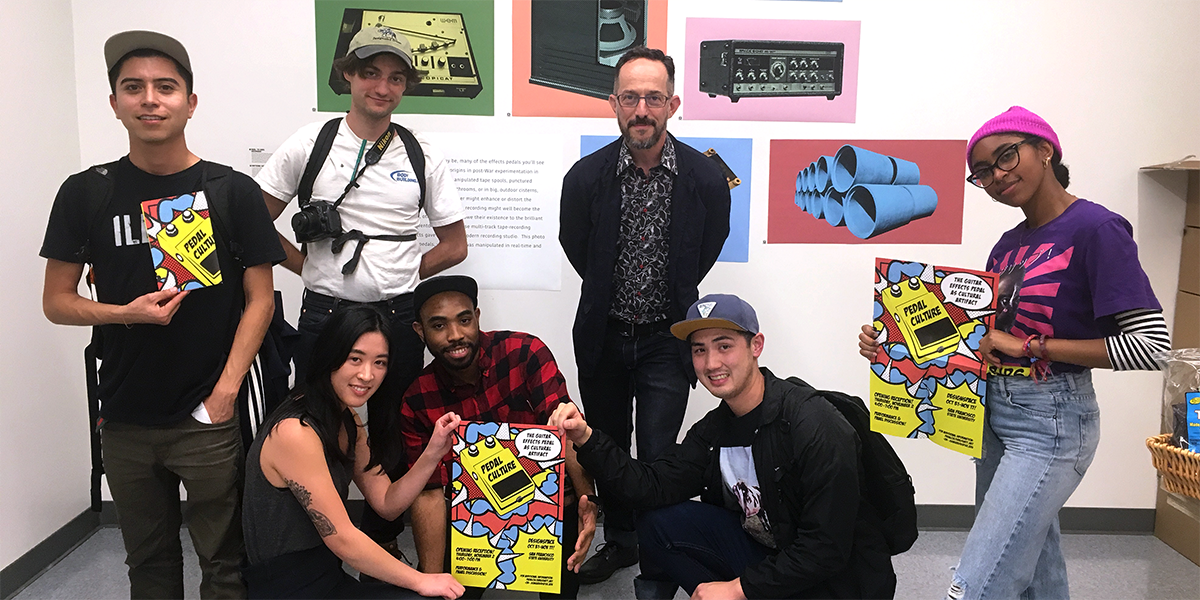
“Some of these are so beautiful that I can’t imagine people actually use them — that people put their feet on them.”
Joshua Singer, associate professor of visual communications in the School of Design, is talking about guitar effects pedals. He is director of DesignSpace, the design gallery now displaying more than 50 popular and famed guitar pedals as part of the exhibition PedalCulture: The Guitar Effects Pedal as Cultural Artifact, which runs until November 17.
“It’s the most ambitious exhibition we’ve put on, yet,” Singer says.
Ron Light (B.A., Anthropology, ’71), an independent arts program developer curated the exhibit, amassing the collection through a variety of pedal sellers and manufacturers, both borrowing and purchasing examples for display.
Not just an exhibit for music lovers, PedalCulture highlights the significance of guitar pedals through avenues of visual design and cultural anthropology, examining how guitar gods like Jimi Hendrix and Kurt Cobain used these tools to influence the musical world and society.
What is DesignSpace?
Located in Fine Arts 115, the exhibit room is running its second year as the newly branded DesignSpace. The purpose of the space is to feature work from designers, panel discussions and performances, and to teach audiences how design affects every aspect of life.
Students in the “Design Gallery: Exhibitions and Communications” (DES 628) course run DesignSpace. From the time a proposal idea is accepted through opening day, the students are heavily responsible for the planning and execution of each exhibition.
“[Students] are responsible for designing the display cases, the typography, the logo and the program — every aspect of the design is theirs,” says Light about his curated show.
Singer remarks that instead of churning out assignments on hypothetical projects, it is exciting to see students witness their pre-production plans materialize into a real show with an actual audience.
“No one’s shut down. Everyone’s ideas are put out on the table,” said AJ Plummer, a Visual Communication Design student and one of many exhibit designers responsible for design and installation.
“[The class is] really hands-on. ...There’s something about building that really awakens that creative spirit,” Industrial Design major Lizzy Johnson says. Johnson worked with Light over the summer conceptualizing potential layouts and branding materials like her Lichtenstein-inspired logo.
The room was formerly known as the Design Gallery, but rebranded as DesignSpace this year to encompass the participatory, collaborative nature it houses more accurately.
“What I find so valuable about DesignSpace is that it becomes a place of discourse,” Singer says. “It becomes a place where conversations start and where we facilitate those conversations based on the things we present.”
Biggest exhibit yet
Light came up with the idea for PedalCulture after taking guitar lessons about three years ago. Despite being a self-professed rudimentary musician and non-gearhead, Light became engrossed in observing the obsessive, religious, even fetishistic attitudes guitarists have toward effects pedals.
“People would collect them incessantly and trade them. …The pedals became an altar and the quest to produce a specific guitar tone became this sort of mythic journey,” he says.
Guitar pedals have been largely significant only to the small, esoteric community of electric guitar players who collect them to chase a signature sound. Considering Light earned his degree in anthropology, it was only natural that he was more interested by the influence the sound effects had on society than the sounds themselves.
With the help of the School of Design, Light wants to pull guitar pedals from obscurity and show them in a new light: as artifacts instrumental in defining the soundtracks for a generation.
Each of the discrete pieces within the show follows a thematic focal point. “Surf n’ Turf” explains the popular reverb effect from the beach music of the 1960s, while the “Praise and Worship” display explores how the spiritual ideology of Christian-band guitarists affects their sound in a holy house of worship.
Cleverness is a virtue within the pedal-collecting subculture. Exhibit designers reflect this in the peepshow display for the euphemistic Big Muff Pi fuzz pedal and the tortilla chip snack station settled beside the Dr. No “Holy Wahcamoly” display.
There are stations where patrons can listen to the songs that made the effects famous and an interactive station where one can experiment with the sounds themselves.
Under the creative hands of the students, “each exhibit becomes more than a display case exhibition, but an actual art installation as a real museum might do,” Light adds.
More than a deep historical examination or a musical catalogue, PedalCulture is “a pop cultural survey,” he describes. “There is fun to be had by all.”
— Gospel Cruz
Links
Photo and video by Gospel Cruz